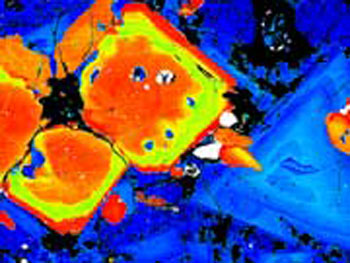| Mar 31, 2012 |
Microscopic, sub-volcanic visions
|
|
(Nanowerk News) The Japanese-built FEG-EPMA (Field Emission Gun Electron Probe MicroAnalyser) forms an integral part of the suite of electron microbeam equipment in the University of Bristol's School of Earth Sciences. The €1 million FEG-EPMA was funded through an ERC Advanced Grant to Professor Jon Blundy entitled 'Critical Behaviour in Magmatic Systems' (CRITMAG). The new instrument will be used to analyse the composition of rocks and minerals at a scale of a few hundred nanometers. In particular, scientists intend to unravel the complex sub-volcanic processes by analysis of lavas and ashes from volcanoes such as Mount St Helens (USA), Nevado de Toluca (Mexico) and Corbetti (Ethiopia).
|
 |
| A Mount St Helens sample, as seen through the electronic microscope, showing zoned crystals.
|
|
Magma (or lava when erupted at the surface) is composed of molten liquid rock and solid crystals. These crystals are often chemically zoned and preserve a record of processes occurring beneath the volcano prior to eruption. The width of these zones varies from millimetres to a few hundred nanometres and contains important chemical information. The crystal zones can be treated in a similar manner as tree rings, which record the growth history of a tree. Instead of counting the number of zones to determine the age of a crystal, scientists use the diffusive relaxation of chemical elements between adjacent zones to retrieve timescales of pre-eruptive processes from days to decades. The exceptionally high spatial resolution of the FEG-EPMA will allow Professor Blundy and his team to access even shorter timescales than were previously possible.
|
|
The ultimate objective of the research supported through CRITMAG is a better understanding of the processes by which magma is transported from the deep crust through the sub-volcanic plumbing system and eventually to the surface, and of the timescales on which transport occurs. Moving magma beneath the surface triggers a host of ancillary signals, such as earthquakes and ground deformation that can be detected by monitoring equipment. By using the new FEG-EPMA to unravel timescales commensurate with the monitoring of signals at active volcanoes, scientists will be able to better understand the significance of pre-eruptive changes to the monitoring signals and so improve the ability to forecast volcanic eruptions.
|
|
|

